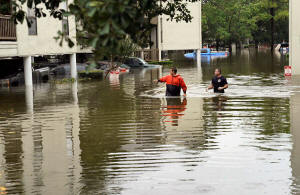|
Stricter building rules, rejected by
Trump, helped Harvey-hit communities
 Send a link to a friend
Send a link to a friend
 [September 02, 2017]
By Julia Harte [September 02, 2017]
By Julia Harte
WASHINGTON (Reuters) - As Hurricane Harvey
pummeled the Gulf coast in Texas, the city of Seabrook had an edge over
flood-swamped nearby towns and the devastation in Houston, just a
half-hour drive away.
Years ago, the city imposed higher elevation standards for buildings
that were stricter than existing federal guidelines on construction in
flood-prone areas. Before leaving office, President Barack Obama sought
to toughen those national rules, to bring them more in line with those
in communities like Seabrook. President Donald Trump, however, revoked
Obama's executive order last month.
Harvey, which has displaced around a million people and flooded swaths
of Houston, has proven an early test of that decision. Floodplain
experts wrote to Trump this week, urging him to rethink his reversal of
Obama's order.
"As we come to the conclusion of Harvey, we have suffered some damage to
our community, but not to the extent that some of our neighboring
communities have. That is partly because of our (elevation)
requirement,” said Seabrook deputy city manager, Sean Landis.
Although Obama’s order had not yet come into effect when Trump rescinded
it, some communities had been concerned about the cost of elevating
existing buildings to comply with the new rules. But Landis said more
stringent rules have paid off in Seabrook. “We feel more resilient,” he
said.

Seabrook's experience illustrates how some American coastal
municipalities, fearing more intense storms and rising seas, have gone
beyond federal standards for building in flood-prone areas. Those
federal rules largely have not changed since the 1970s, when there was
less evidence of the effects of global warming.
In Texas and Louisiana, for instance, communities comprising two-thirds
of the nearly 8 million people affected by Harvey have updated their
flood protection standards beyond federal requirements since 1990, as
part of a federal program that in return discounts their flood
insurance, according to a Reuters review of municipal codes.
Trump rescinded the Obama standard as part of an executive order aimed
at speeding up the permitting process for federally funded
infrastructure. It was the latest in a series of moves by Trump to
repeal Obama-era rules aimed at girding the United States against
climate change, which Trump has described as a hoax by the Chinese
government.
Public assistance grants from the Federal Emergency Management Agency
currently require structures to be built at or above the “100-year”
flood elevation: the level that waters would reach in a flood that had a
1 percent chance of occurring in any given year.
"REBUILD HOUSTON SMARTER"
In its Aug. 29 letter to Trump urging him to rethink his decision, the
Association of State Floodplain Managers called on the president to
"rebuild Houston smarter."
Chad Berginnis, the association's executive director, noted that federal
funding for rebuilding of communities hit by Hurricane Sandy in 2013
came with strings attached - new structures had to be elevated a foot
(31 cm) higher than the normal federal standard.
"Thousands of structures have been rebuilt under that standard, and we
haven't heard any complaints at all in terms of it being something
difficult or impossible to do," Berginnis said.
When asked whether the administration might require post-Harvey disaster
relief recipients to use the Obama-era standards when rebuilding, Roy
Wright, the director of FEMA's National Flood Insurance Program, said,
"That is a conversation for another day ... I'm sure informed decisions
will be made."

Obama’s order would have required federally funded structures to be
built at one of three elevations: the level that waters would reach in a
flood that had a 0.2 percent chance of occurring in a year, 2 to 3 feet
above the federal requirement, or at a level to be devised based on
climate science projections.
[to top of second column] |

Men look for people wanting to be evacuated from the Hurricane
Harvey floodwaters in Dickinson, Texas, U.S., August 28, 2017.
REUTERS/Rick Wilking/File Photo

The city of Seabrook in 2008 raised its standard to one foot above
federal levels, according to municipal records. Last November, the
city council voted to raise it 6 inches higher than that.
Seabrook’s former mayor, Jack Fryday, now works as a city building
official for Taylor Lake Village, another community near Seabrook in
the Galveston bay area, where he said the elevation requirement is 3
feet above the federal level.
After Hurricane Ike struck the area in 2008, most people who lived
along Taylor Lake raised their buildings, except for a handful of
houses, according to Fryday.
“Those five or six that hadn’t elevated are the ones that got water
in their houses during Harvey,” Fryday said.
HIGHER STANDARDS
When Obama first issued his executive order, it drew fierce
criticism from the National Association of Homebuilders, a housing
trade group. The new standards had a "chilling effect" on builders
because they would have raised the costs of any building using
federal mortgage insurance, according to the association's chief
executive officer, Jerry Howard.
"The rules, as they were put out for comment, were overly
intrusive," he said.
In some of the areas hardest hit by Harvey, however, local officials
say the increased upfront costs save them far more in rebuilding
costs after a major flood event.
In 2002, the year after Hurricane Allison ravaged much of the Gulf
coast, Texas’s most populous county, Harris, adopted new
requirements that regular buildings be built 18 inches higher than
federal elevation requirements.
Critical facilities – such as police departments, schools, and fire
stations – must be 3 feet higher. Houston is in Harris County, but
the city’s elevation requirements are slightly lower than the
county’s rules, which apply to Harris County communities that do not
have their own city governments.
"We have much higher standards than the feds," said John Blount, the
county engineer for Harris County, as Harvey raged outside his
office.

Blount said he had not closely studied Obama's executive order
before it was revoked, but he thought it looked more like a
bureaucrat's wish-list than an actual flood management standard - in
part because it had not yet been turned into policy.
“Obviously we’re not concerned about having stronger regulations,
because we have some of the strongest in the country. Some of the
provisions in the (Obama) act made sense, but it also had a lot of
fluff,” he said.
Building officials for communities that have not raised elevation
requirements beyond the federal level were harder to reach during
Harvey's rampage across southeastern Texas, but Galveston County
engineer Michael Shannon answered Reuters' questions by email.
The county had not recently considered adopting a higher standard,
he wrote in a brief message. "As flood levels are rising at my home,
I may be evacuating today," he added.
(Additional reporting by Valerie Volcovici; Editing by Jason Szep
and Ross Colvin)
[© 2017 Thomson Reuters. All rights
reserved.]
Copyright 2017 Reuters. All rights reserved. This material may not be published,
broadcast, rewritten or redistributed. |